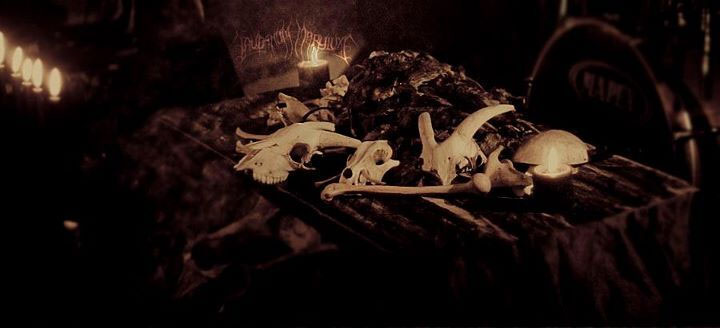Vassafor
2016-09-14
by Niklas Göransson
From the depths of the South Pacific, ancient curses still resound over blood-stained altars. Introducing Vassafor – performing music largely composed through lucid dreaming and named after a patron that appeared among the stars.
– The new record is almost entirely done – right now we’re peppering in the last chaotic elements.
In this final stage, and true to VASSAFOR tradition; bass player, guitarist and vocalist Phil Kusabs says they’re implementing layers of subtle additional audio.
– Not binaural beats or whatever, but we like to have a lot of things going on in the background, just beneath the surface; samples, sound elements and tones among other things. Anything that helps in reaching out and tugging on the listener’s subconscious.
Phil says this type of sonic manipulation is barely discernible for the untrained ear but that kindling the hearing is not the aim; it seeks to alter the listener’s headspace.
– Manipulating their line of reasoning, influencing thought patterns or even pulse rate. Anything to lull the audience into the state you want them in as they receive the information. It’s one of the main reasons the vocals are lower in the mix than is traditional; it encourages listening a little bit more intently, and therefore entering a state perfectly receptive for indoctrination.
This kind of subtlety is a far cry from the iron gauntleted approach that is traditional metal. Phil explains that for a long time, he was captivated by the dark drum’n’bass scene.
– Some of the fucking sound coming out of there was just … it was horrific. You’d go to these venues and get just smashed by frequency, especially from some of those low ends. It would literally move your internal organs. I think it progressed from my interest in the extremity of sound that SWANS, WHITEHOUSE or especially early LAIBACH brought to their sonic hell.
Some of the leading artists came straight from the industrial scene, bringing with them steely madness.
– Especially that German scene of the mid to late ninties – mainly music put out by labels such as Digital Hardcore and Force Inc.
Phil mentions artists like Shizuo, Heinrich at Hart or Cristoph de Babalon as being ‘absolute audio terrorists’, and at the same time incredible sound engineers.
– They worked with fucking people up, and the range of sensations they could stir was incredible. That’s been a huge influence to me, as a self-taught sound engineer myself. I’m trying to do similar things, translated into a completely different musical setting.
An equally important influence was the way the scene would refuse to settle for the conventional and so built their own sound systems to circumvent technical limitations.
– The English producer Dillinja had a 75 000 watt PA that he made himself, it had these fucked up kind of hexagonal subs that were just throwing up sound. They were placed along the floor; the music would basically soak up from your legs so you’d have this bass that would absolutely rip through you – distorted as fuck on the tops as well.
Phil stresses that this was harsh music and most definitely not ‘nice little cheerful dance shit’.
– You’d have heaps of idiots popping happy pills like they were going out of fashion, trying to get all loved up and have a good time and then just get fucking annihilated by bass terror. It was appalling, he says fondly, I loved it.
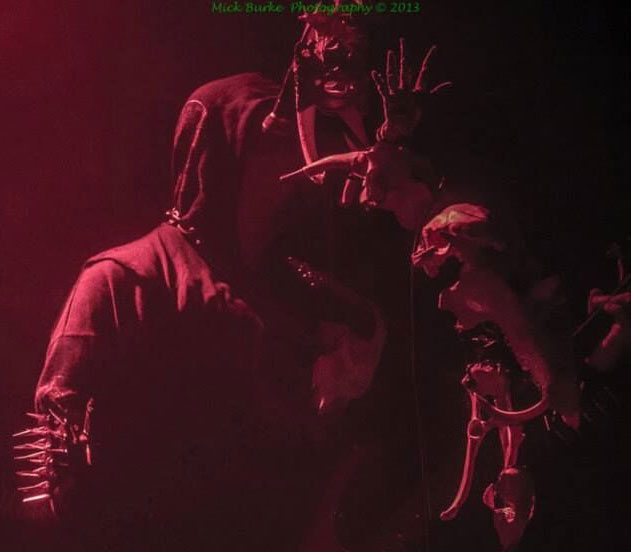
Google shows no hits for ‘vassafor’ that are not related to New Zealand black metal, leading me to suspect that Phil is the word’s originator.
– It’s from a series of lucid dreams I had as a child. I was obsessed with the stars and would sit gazing at them come nightfall, as I’m sure kids have from the dawn of time.
The seventies were the great age of space exploration and general interest in it was at an all-time high.
– My mum was a primary school teacher, she’d bring home stacks of National Geographic magazines that had pull-out maps and astral charts. My ceiling was covered with them, so I’d always go to sleep looking at the night sky.
Phil describes drifting off into a trance state, mesmerised by the stars – gradually losing his ability to determine whether his eyes were still open or not.
– I’d find myself in these vivid, celestial dreams. After a while I felt as if I was floating through space, and being taken places. There was an undeniable feeling of a presence guiding me, almost like a teacher-type feeling – this evolved into the entity I came to know as Vassafor. I was told that he was my patron and that’s how it’s been ever since.
Phil’s description bears a striking resemblance to what people report from drinking ayahuasca – a powerful psychedelic brew traditionally used by tribes in the Amazonian rainforest. It’s made from boiling the vine it’s named after together with leaves from certain bushes or trees. The leaves are rich in a potent psychoactive substance called DMT, which is what activates the potion’s visionary aspect. It’s found all through nature and even occurs endogenously in the human body.
Have you ever ingested DMT in any form?
– No.
Scientists speculate that nocturnal DMT emission might be what induces dreaming. Some people appear to have an overactive DMT production, which can accidentally send them unawares on a powerful psychedelic trip. Leading researchers such as Dr. Rick Strassman suggest that this might explain the so-called alien abduction phenomenon, after many of his subjects reported similar experiences during DMT trials at the University of New Mexico in the early nineties.
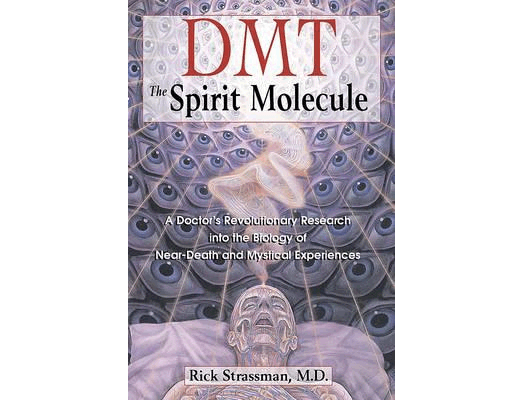
– Interesting, Phil says, I’d imagine so then. It would happen regularly; some were supremely ‘long’ and it felt like I was completely outside of time.
The perception of time being dissolved entirely is another sensation commonly reported by ayahuasca drinkers.
– When I read The Lightning and the Sun by Savitri Devi and came across the concept of ‘man above time’, it instantly made sense to me. This is what I’ve always been striving for, as an individual as well as a musician. VASSAFOR’s music is meant to fold space and time, and open wormholes to other dimensions.
Regardless of what the catalyst might have been, Phil states that these experiences unquestionably had a profound influence on him.
– I really think they made me into the person I am today.
This space from Phil‘s childhood is also the source of much of VASSAFOR’s musical output. In the semi-lucid dreams he’s been having his entire adult life, he’ll often find himself back in that timeless void where he’ll occasionally hear floating streams of music.
– In the nineties when this began, I’d often have to have to will myself awake so I could stumble out of bed and grab my guitar to record the melodies.
As he grew older, he trained himself to better recall the ethereal melodies.
– I had to. There’d be these incredible passages and I’d just feel … I’d wake up and they’d be just on the other side of that fog where I couldn’t quite grab them.
Fortunately, the mists have yielded some tangible harvest.
– I started working on “Archeonauts Return” from “Obsidian Codex” as early as 1995. Perhaps seventy percent of it was brought back from the subconscious so there’s a lot of quite strange and almost backwards stuff – that’s the kind of shit that comes out as these sleep riffs.
Phil suggests that the unorthodox and weird forms these melodies often take is from having undergone a violent filtering process that’s left them warped and twisted.
– It might not be entirely accurate to what I heard in the dream but when you’re in the thick of it all, it’s the animating spark that you end up keeping.
Whether the source can be traced back to the subliminal, if they’re gifts from the Muse or of oracular origin – Phil says he doesn’t necessarily want or need to know.
– I think that trying to explain and catalogue everything can completely kill it. No point in shooting the goose to dissect it for answers if it keeps laying golden eggs. It’s important not to be too scientific, some room should be left for imagination.
In concert, VASSAFOR leave very little to the imagination. They are renowned for espousing an ambitiously abbatorial approach to stage décor; craniums and bones from a variety of animals, as well as expired rodents by the hundreds.
– Okay, he says, first of all – what is it that makes you remember a specific moment in time? How do you learn? There are many ways of doing it, but it occurred to me that reconnection to lost memories is often triggered by sensory stimulation.
With the third eye pried open by the proverbial megawatt strobe, the message is hammered straight into the subconscious.
– Often you’ll listen to music and it will bring you back to a previous moment in time where you heard the same song, or you’ll smell something and it will rekindle an associated memory. If you want to inject reminiscence into someone’s mind – what’s the best way to do that? It seems to me that rousing as many of the senses as possible is the way to go.
The commonly accepted five senses are hearing, sight, touch, smell, and taste.
– Taste is the hardest one obviously, you can’t really target it unless you get everyone present to drink or eat something – and good luck with that. But half of taste is smell really, so you can kind of get that going.
The sense of touch should presumably be stirred by the volume they’re playing at.
– It should reach the point where you can physically feel air pressing against you from the oppressive force in the music – senses assaulted on all fronts and the subconscious torn open.
Before I need ask, Phil informs me that the carnal accessories stem from drummer Ben Parker’s previous career in faunal irritant eradication.
– He’d bring home bags and bags of dead rats. Into the freezer they went, to be pulled out and tied together when needed. The last time we did a local show we had something like 120 of them on stage.
Do you recycle?
– Actually, yes. Some of them have been thawed out, put on the altar and used for a gig and then put back in the bag, frozen again – repeat the cycle. It’s turned into this morass … a miasma of rat flesh, fur, guts, teeth; everything just melded together. It’s quite a special smell.
That’s not the only aroma knocking about, VASSAFOR also make their own incense and candles.
– If we have a set that’s roughly 45 minutes long – the incense will last up to 25 minutes. We use a lot so it fills the air like a dense, pungent fog. Then we have things like white sage, sandalwood, dragon’s blood, and myrrh, which are materials closely linked to necromancy.
The incense fades towards the middle of the show and gives way for the sickly sweet scent of decay.
– Then you have the visual presentation and that’s where we try to capture the death worship aspect as well – we’ve also used human skeletons and skulls as well, not just animals.
‘Death worship’, why does something that courts men of all faiths need any adoration?
– Veneration might be a more accurate way of putting it. The great, collective dumbing-down of this society and consciousness has divorced modern man from any kind of … not just introspection, but even critical thinking.
The prime purpose of surrounding themselves with death and bones is the absolute solidification of the transitory nature of life.
– The flesh is weak and temporary, something people prefer not to think about. Most just bask in this total unconscious, whereas I like to be based in reality. That’s where death worship comes from, it anchors us into our present.
Memento mori.
– Absolutely, that’s right.
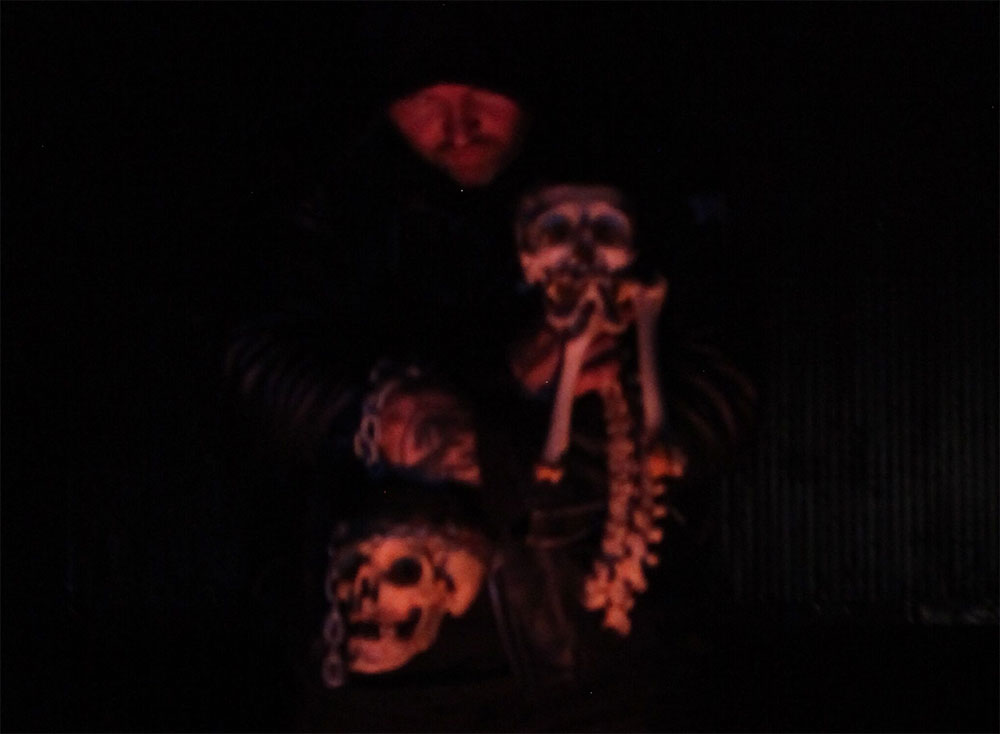
In stark contrast to the solemnity when discussing issues of mortality, Phil’s tone changes completely as we turn to the topic of cassettes. Tapes appear to be one of his greatest sources of pleasures in life.
– I love tapes, he says affectionately, not all of our releases are on tape yet but it’s merely a matter of time. I fucking love tapes. I still have heaps of demos that I got when I was a teenager, and I’m 44 now.
That’s several lifespans for the average cassette, an oft-cited contribution to their diminishing appeal.
– If you don’t treat them like shit they’re normally pretty good, he says with a sublime underlining of murder, I think tape is a much-maligned format and unjustly so. You can get a killer tone with a crappy tape deck and a piece of shit microphone on it – the amount of amazing jams with drums that sound crushing that I’ve done…
Seeing as Phil works as a mastering engineer, one would have to ascribe at least some validity to his opinions. Besides tape apostasy, another significant annoyance is one he’s subjected to in his professional capacity; ‘Umm, we just really want it louder.’
– You’re a fucken’ idiot, he snarls, that’s the worst … you want it louder? Turn the fucking volume up! All you do when you have this false-loudness worship that any halfway decent mastering or mixing person will tell you is garbage, is compressing the shit out of it. The more you turn it up and brickwall the master, the weaker it will sound through a stereo at higher volumes.
There are exceptions to this obviously, especially with high-end mastering.
– I just don’t really see the point when you can have incredible-sounding records that are not smashed level-wise. They’ve got dynamics and can breathe, and the louder you turn it up the heavier it will sound.
Unsurprisingly, this brings us back into the wonderful world of analogue amour.
– Tape is one format where you can actually smash it, because tape compression sounds awesome. Every drummer is going to love being recorded on a reel-to-reel. It sounds juicer and you can feel the dynamics of the playing, you can hear the feeling of it. All these travesties said about them, it’s like… fuck off you wankers, tapes rule!
I’m assuming you’re still releasing your demos on cassettes?
– It’s no fucking demo if it’s not on a tape, I’m going to tell you that right now. Demo CD’s are worthless, any band that releases their fucking demo on a CD-R … why would you even put your name to that shit?
Upholding tradition is a metal fundamental, but he concedes that there’s also space for innovation.
– While that may sound counter-intuitive, it’s a great way to have two facets of the whole. And I think the traditional method of a band smashing out a demo tape worked pretty good for the last 40 odd years, so I see no reason why that should change.
A situation that has changed recently is Phil’s orchestral undertakings, after having moved from Sweden back to his home of New Zealand.
– Now that I’m back on this side of the world I’m no longer playing with IRKALLIAN ORACLE. It’s more practical to stick with southern hemisphere bands, keeping it within a couple of time-zones of each other.
That was one of the issues from Phil’s time with Canadian legends BLASPHEMY.
– Being so far away from Vancouver was difficult when it came to coordinating gigs, rehearsals, travelling and so on. Not ideal for either those guys or myself. It’s tough doing shit long-distance, so TEMPLE NIGHTSIDE and obviously VASSAFOR are the bands I’ll focus on henceforth.
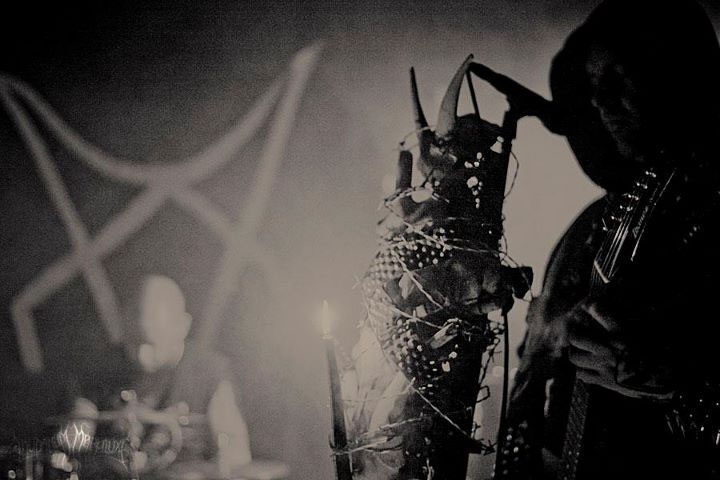
Along with tapes, Phil has an equally profound reverence for the bass guitar.
– I love the fundamental philosophy behind it, the notion of it being a crucial building block in the structure of sound. You’ve got the rhythmic aspect but it’s still melodic. It’s an anchor, and you can go in any direction from it.
When writing a song, Phil relies primarily on the four strings to provide melody, rather than the traditional six.
– I often prefer the guitars fairly simplistic, done more like a razor to the throat whereas the bass is kicking the fucking head in.
I sense a NECROMANTIA fan.
– Oh yes. I’ve actually just been working on a few songs in that nasty Greek style that I love so much, for a new band. When I wrote “Makatu”, it was all on bass and I went: Why the fuck am I not doing a bass-only band? I’ve kept that in mind the whole time and now finally I am, so we’ll smash a demo out of that at some point – on tape, needless to say.
The song he mentioned, “Makutu (Condemned to Deepest Depths)”, is from the debut album. The title is in the language of the indigenous population of New Zealand, who are collectively called Maori.
– It’s not a race, more of a group. The Maori are comprised of multiple different iwis – tribes, similar to the First Nations and Native Americans.
Much like the British, Phil’s journey to the Maori began in Europe.
– As a young man trying to find my way, I was a voracious reader and devoured as much as I could. I’ve got a large Scandinavian heritage, as well as some Polish and Irish and so I looked to the roots of my blood. What I found were rather interesting systems that I’ve certainly retained aspects from, but never fully resonated with.
Building on what he’d found through his pedigree, Phil went on to study concepts of the ‘traditionally Satanist’ Order of Nine Angles. This is the foundational framework he has been building on ever since.
– There is Maori ancestry in one branch of my family, so I started learning more about them. That’s when I discovered the tohunga and their magical traditions.
The tohunga is a master practitioner of a specific art or skill – secular or sacred. Depending on their chosen craft they’d be historians, healers, clerics, diplomats, academics, teachers or practitioners of makatu – sorcery.
Without any access to proper tutelage he read everything he found about it, until the turn of the millennium when he came across someone through work he had done. Not only did this person know about makatu, he organised for Phil to interview one of the elders of his iwi.
– That really blew my mind, it had a profound influence on me. It’s got a shamanistic element but also a medicine man and venerated elder aspect. The knowledge was kept alive primarily by oral tradition, much like the Vikings, it wasn’t a written culture but there’s heaps of carvings, stories, songs and so on.
The song in question is based on an actual historical case from 1863, of a tohunga being hanged by the crown for witchcraft. According to the charges, he lay a curse on a rival chief who then withered away and died over the course of the following seven days.
– The majority of the song is slightly paraphrased, but it’s essentially the curse he placed on his opponent.
Phil describes New Zealand as a young country – wild and primordial.
– This corner of the world is in my DNA, it has resonance to me. More so than any Middle Eastern philosophy or gods from foreign lands; had I been born there they might have had more of connection with me, but I wasn’t – I’m from here. There’s a lot of untapped energy here and you can feel it, especially when you’re in tune with the soul of the land.
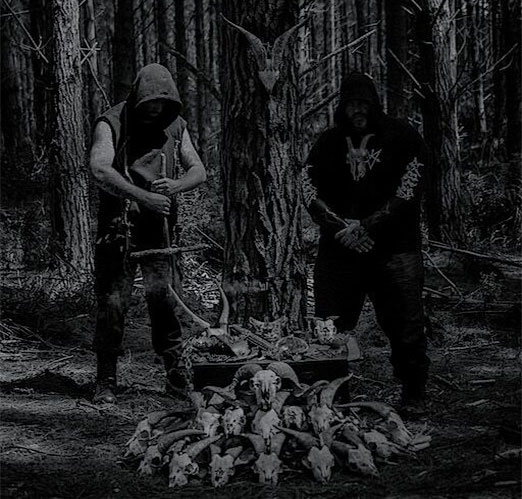
Besides a MZ.412 cover on a tribute album to the old Swedish label Cold Meat Industry, VASSAFOR’s latest release was the 2015 compilation CD “Invocations of Darkness”.
– It’s a collection of every piece of music we’ve recorded since Ben joined. We’ve been working together since 2009, which was the rebirth of VASSAFOR. I’m really satisfied with everything since, we operate on a similar wavelength and share the same vision – we’re motivated by the same things.
The primary purpose of “Invocations of Darkness” was to take advantage of the CD format – collecting on a physical album that’s cheap to post, music that had only been available on tape or vinyl such as the debut album.
– As we here in New Zealand know, if you want to buy an LP from Europe or especially from the States, the postage is twice as expensive as the actual release. It’s fucking savage and is absolutely hammering the underground.
Phil says he has no problem with people downloading his music.
– I don’t give a fuck. The people who are possessed by it and want to have it, they are the ones I want listening to our music; those who like having the actual record in their hands, because that’s how I am myself.
The compilation features three CD’s containing two and half hours of music, sold for the price of a regular album. It has no exclusive material out of respect for those who already have the vinyl.
– One of the CD’s show a more black metal and aggressive side to VASSAFOR. Then there’s a traditional disc; songs in which our influences shine through a lot, as well covers of bands that have been important to us. The third has more of a doomy and collated feel, real fucking death worship.
Instead of track-listing the songs in chronological and discographic order, they’re divided by their style and feel.
– I thought it would be much more interesting to consider the kind of things we’re focused on – what we listen for in music, and arrange them thematically after that.
Would you say there’s magic in your music?
– How do you even… magic, music – I think they are exactly the same thing. Can you tell me what magic is? It’s an impossible question to answer, but what you’re essentially attempting to do is manipulate the forces around you to influence things in a way you want. And what is music, but that?
In both conjuring arts, the practitioner invokes something from a state of inexistence and evokes it into this sphere. It’s the same principle, regardless if the spellbook is inscribed with writing or bars.
– Especially with a lot of formulaic esoteric traditions, and I mean that as in formula-based magical rites that gain in power through repetition and refining. This is the same path you take in music.
Phil speculates that this is why a lot of musicians are also practitioners of ‘the sinister tradition’.
– That involves anyone that walks a road they’ve carved out for themselves. The idea of the left hand path is not necessarily one that must be traversed in solitude, but it does have to be your own; as opposed to simply beating the same trail that’s been trod on a million times before you.




